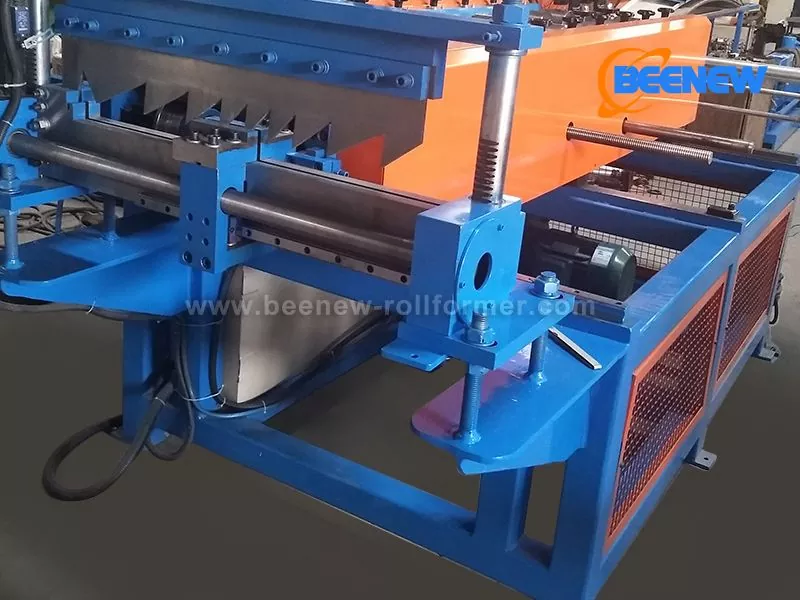The Hazards of Roll Forming Machines: What You Need to Know
2024-10-12
Roll forming machines are essential equipment in the manufacturing industry, especially for producing metal components like sheets, channels, or panels. While these machines are highly efficient and capable of shaping metal into precise designs, they also pose significant hazards if not properly managed. Understanding the potential risks associated with roll forming machines is crucial to ensuring the safety of workers and maintaining a productive work environment.
In this blog, we’ll explore the common hazards of roll forming machines and offer safety tips to help mitigate these risks.
1. Crushing Hazards
One of the most severe risks when working with roll forming machines is the potential for crushing injuries. The machine’s rollers, dies, and moving parts can easily crush fingers, hands, or other body parts if they come into contact with the equipment while it’s in operation.
Causes:
- Lack of guarding on moving parts.
- Workers reaching into the machine to adjust material or clear jams while the machine is running.
- Insufficient training on safe operating procedures.
Safety Tips:
- Install and maintain proper guarding around rollers and moving parts.
- Use automatic material feeding systems whenever possible to reduce manual handling.
- Ensure that workers are trained to keep their hands and other body parts away from the rollers and to never attempt to clear jams while the machine is in operation.
2. Entanglement Hazards
Loose clothing, hair, jewelry, or even tools can get caught in the moving parts of the roll forming machine, leading to serious injuries. These entanglements can pull workers into the machine or cause severe damage to limbs.
Causes:
- Improper personal protective equipment (PPE) or loose-fitting clothing.
- Lack of attention to securing long hair or jewelry.
- Poorly maintained machine parts that increase the chance of snags.
Safety Tips:
- Ensure that workers wear tight-fitting clothing and remove any loose items like jewelry or watches.
- Require workers to tie back long hair securely.
- Regularly inspect the machine to ensure there are no protruding parts that could cause entanglement.

3. Pinch Point Hazards
Roll forming machines have multiple pinch points—areas where moving parts come together and could trap or crush fingers or other body parts. These pinch points often occur where the rollers engage with the metal being processed.
Causes:
- Workers placing their hands too close to the pinch points while feeding or adjusting the material.
- Lack of clear signage or warnings about pinch point areas.
- Absence of adequate protective barriers or emergency stop mechanisms.
Safety Tips:
- Clearly mark all pinch point areas and install warning signs.
- Use mechanical feeding systems to avoid manual material handling near pinch points.
- Equip the machine with easily accessible emergency stop buttons or pull cords.
4. Flying Metal Fragments
During the roll forming process, sharp edges, metal fragments, or offcuts can be ejected from the machine at high speeds, posing a risk of eye injuries or cuts. Workers in the vicinity of the machine are especially vulnerable to these flying debris hazards.
Causes:
- Poor handling of metal sheets or coils.
- Defective or improperly aligned tooling that causes irregular cuts or fractures in the material.
- Inadequate PPE, such as safety glasses or face shields.
Safety Tips:
- Ensure workers in the roll forming area always wear appropriate PPE, including safety glasses or face shields.
- Regularly inspect and maintain tooling to ensure accurate cuts and prevent material defects.
- Use protective shields around the machine to contain flying debris.
5. Electrical Hazards
Like all heavy machinery, roll forming machines operate on high-voltage electrical systems, and electrical hazards such as shocks, short circuits, or fires are potential risks.
Causes:
- Faulty wiring or poor electrical maintenance.
- Exposed electrical components due to wear or damage.
- Improper lockout/tagout (LOTO) procedures during machine maintenance.
Safety Tips:
- Regularly inspect the electrical components of the machine and repair any damage immediately.
- Implement strict lockout/tagout procedures during repairs or maintenance to ensure the machine is completely powered off.
- Ensure that only qualified personnel handle electrical repairs and maintenance.
6. Noise Hazards
Roll forming machines can generate high levels of noise, especially in large-scale operations. Prolonged exposure to excessive noise can lead to hearing loss or other auditory issues for workers.
Causes:
- Continuous operation of heavy machinery without proper sound dampening or insulation.
- Lack of hearing protection in the work environment.
- Insufficient maintenance that causes the machine to run noisier than usual.
Safety Tips:
- Provide workers with hearing protection, such as earplugs or earmuffs, if noise levels exceed safe limits.
- Monitor noise levels regularly and implement noise control measures like sound barriers or insulation.
- Maintain the machine to reduce unnecessary noise from worn-out parts.
7. Material Handling Hazards
Handling large metal coils or sheets that go into the roll forming machine presents its own risks. These materials are often heavy and difficult to maneuver, leading to strain injuries or accidents if not handled properly.
Causes:
- Improper lifting techniques or attempting to move heavy materials manually.
- Lack of mechanical aids, such as cranes or lifts, to assist with material handling.
- Poor organization in the workspace, leading to tripping hazards or unstable stacks of material.
Safety Tips:
- Train workers on safe lifting techniques and provide mechanical assistance when handling heavy materials.
- Keep the workspace organized and free from clutter to avoid trips and falls.
- Use material handling equipment like forklifts, cranes, or hoists to move large or heavy materials safely.
8. Fire Hazards
Fire risks may arise from various factors, including electrical issues or the accumulation of flammable materials near the machine. Additionally, overheating of the machine or friction between components can lead to sparks that ignite nearby materials.
Causes:
- Electrical malfunctions or overloaded circuits.
- Poor housekeeping, allowing flammable materials to build up around the machine.
- Inadequate machine cooling or lubrication.
Safety Tips:
- Regularly clean and maintain the machine to prevent the accumulation of debris or dust.
- Ensure that electrical systems are not overloaded and are regularly inspected for faults.
- Keep fire extinguishers nearby and train workers on fire safety protocols.
Final Thoughts
Roll forming machines are powerful and efficient, but they come with inherent hazards that must be addressed through safety protocols, proper training, and regular maintenance. By recognizing the risks and implementing the necessary safety measures, manufacturers can protect their workers while maintaining productivity.
Ensuring that workers are trained, equipped with proper PPE, and aware of potential hazards is crucial to preventing accidents and creating a safe work environment around roll forming machines.


